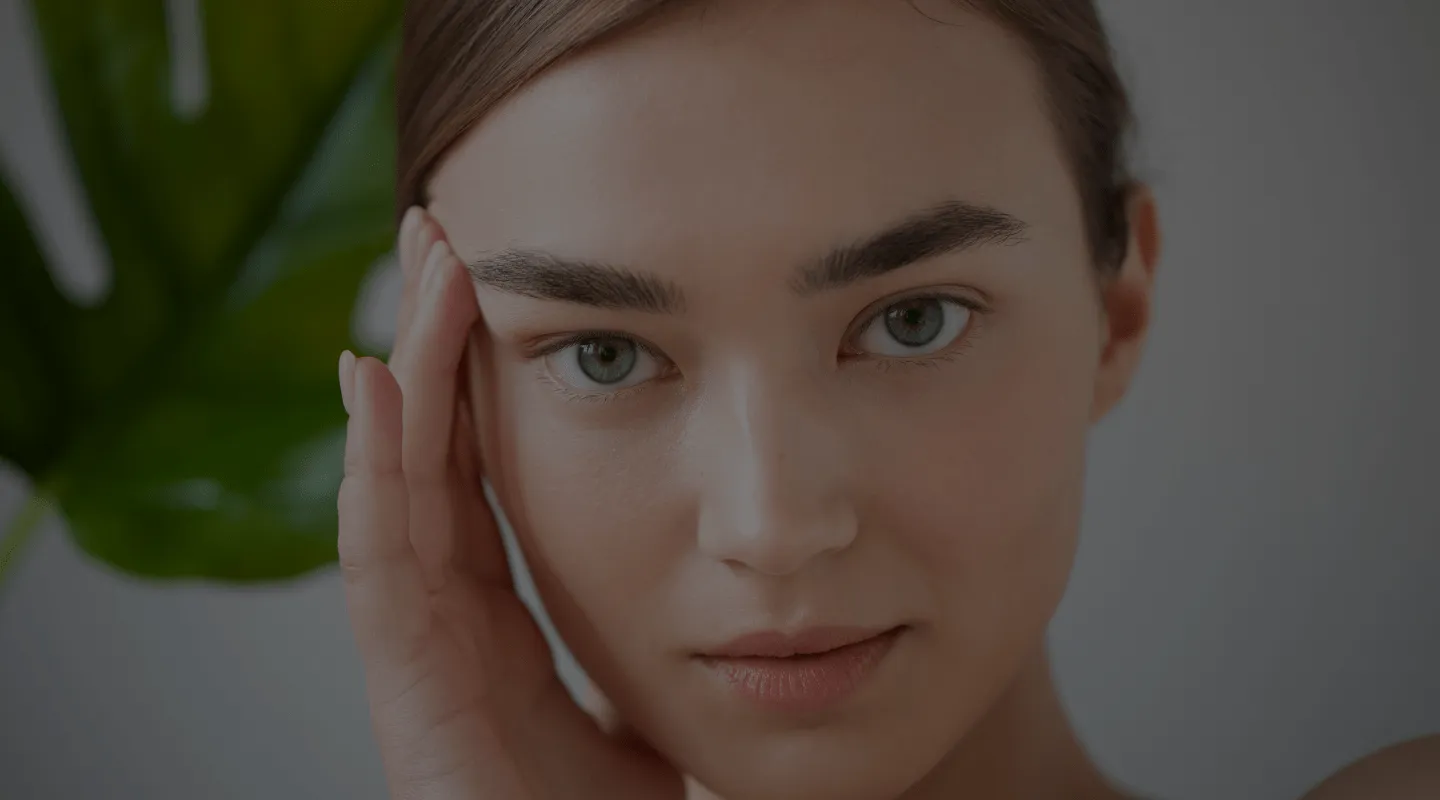
Eyebrow Transplant
Your Affordable Eyebrow Transplant in Tunisia
Restore density, shape, and elegance to your look.
How does it work?
What is an eyebrow transplant?
Eyebrow transplantation is a cosmetic surgery procedure that allows patients who have lost their eyebrows completely or partially due to burns, accidents, or illnesses, or those with thin eyebrows due to genetic reasons, to partially or fully reconstruct them, restoring their volume and thickness. The doctor performs this operation by extracting follicular units to thicken the eyebrows from the donor area, which is generally the nape of the neck. Then, the harvested follicular units are grafted into the recipient area.
Eyebrow Transplant: When and Why?
The eyebrow transplant procedure is indicated when the patient presents one or more of the following conditions:
- Irregular, asymmetrical, or uneven eyebrow shape;
- Thinning and absence;
- Discontinuous eyebrows;
- Too thin shape;
This procedure is not recommended when the hair shaft is too thin and therefore very different from the average diameter of the eyebrows. It is also not advisable when the hair is curly. If the hair is a different color, the patient must be aware of the need to dye it afterwards. The goal of the procedure is to implant hairs from the donor area into the affected area in order to define or restore a certain eyebrow shape.
What is the average price of an eyebrow transplant in Tunisia?
More and more women and men are opting for an eyebrow transplant in Tunisia. The price of an eyebrow transplant in Tunisia is inexpensive compared to prices in Europe. The intervention and hygiene conditions are comparable to those of European clinics. Patient care in Tunisia is unparalleled. It remains personalized and adapted to the patient’s specific needs.
Your health, our priority.
Request your free quote.
Who is a good candidate for this type of transplant?
An eyebrow transplant is a cosmetic procedure that aims to restore or redefine the eyebrow line using hair follicles taken from another part of the body. A good candidate for an eyebrow transplant would be a person who has partial or total eyebrow loss due to factors such as genetics, over-plucking, scars, or medical conditions. This type of patient may consider an eyebrow transplant to achieve a fuller, more natural eyebrow appearance. Eyebrow implantation is usually performed by a doctor specializing in hair transplants who has expertise in this specific technique. It is essential to consult a transplant doctor to properly assess the feasibility of the procedure and obtain optimal results.
What are the common techniques used for eyebrow transplants in Tunisia?
Eyebrow transplantation is a bit different from hair transplantation. Eyebrows have a strong follicular inclination that also varies depending on the specific position of the follicles. In addition, only (or almost exclusively) monobulbar follicular units are present. The transplantation must therefore take both of these factors into account. In order to undergo this operation, it is necessary to check whether the hair that will be transplanted into the affected area has a consistency similar to that of the eyebrows. Patients with too thin hair, for example, will not obtain an appreciable result.
The fundamental characteristic of the technique used is that there is no scar in the donor area. Follicular units are harvested from the back of the neck, the area of the scalp where the hair is normally thicker. The follicular unit is inserted into the model agreed upon with the patient, taking into account the particular anatomy of the eyebrows. Normally, a single session is sufficient, but in case of total reconstruction, a second session may be necessary. We must remember that the grafted hair will continue to grow at its natural rate. Similarly, the eyebrows will therefore need to be trimmed with some frequency.
How to choose the shape of your eyebrows?
The eyebrow can be divided into 3 parts. These three parts have different characteristics that must be kept in mind during an eyebrow transplant. Taking into account the natural characteristics of the eyebrow, you will be able to obtain a natural-looking transplant. The three parts that make up the eyebrow are:
- Head: inner area and turned upwards by about 0.5-0.7 cm. Here the hairs are lighter than in the central part;
- Body: central area approximately 2.5 cm long, voluminous and wide;
- Tail: these are the last 2 cm that connect the central part of the eyebrows to its end. It is a less voluminous area that gradually becomes thinner and is made up of finer hairs. This area becomes increasingly sparse over the years;
The choice of eyebrow shape is made taking into account some basic coordinates, three of which are:
- The beginning of the eyebrow (the head) must be parallel to the beginning of the eye (lacrimal duct);
- The body must have its highest point in the center of the eye, at the same angle as the end of the eyebrow;
- The final point of the eyebrow (the tail) must be given on an imaginary line going from the side of the nose to the end of the eye and parallel to the eyebrow;
What precautions should be taken before and after an eyebrow transplant?
The potential risk of an eyebrow transplant is that the new hair follicles do not implant correctly. In this case, it may be necessary to repeat the procedure in the future. There are also risks associated with the operation itself. Talk to your surgeon about potential complications. Among these complications, excessive bleeding, nerve damage, swelling, bruising, infection, and scarring should be mentioned. Before the eyebrow transplant, the surgeon will review your medical history with you. Be sure to disclose any underlying health conditions, as well as any medication or supplements currently being used.
An eyebrow transplant may not be suitable if you have:
- Alopecia areata;
- Trichotillomania;
- Bleeding disorders;
- A history of complications related to cosmetic surgery;
What is the recovery process like?
The recovery process after an eyebrow transplant is crucial for achieving optimal results. After the procedure, it is normal to experience mild pain, swelling, and redness in the eyebrow area. The surgeon may prescribe analgesics and anti-inflammatories to alleviate post-operative discomfort. It is crucial to follow the surgeon’s instructions regarding post-operative care, including avoiding touching or scratching the grafted area.
In the first few days, scabs may form, but it is important not to pull them off, as this could damage the newly implanted follicles. After a few weeks, the scabs fall off naturally, and eyebrow regrowth begins to appear. It should be noted that eyebrow regrowth can take time and vary from person to person, but in general, the final results are noticeable after several months. During the recovery period, it is recommended to protect the eyebrows from UV rays by using sunscreen and to avoid strenuous activities that could lead to excessive sweating. Patience and following the surgeon’s recommendations are essential to allow the eyes to regain a natural and harmonious appearance after an eyebrow transplant.
How long is the eyebrow transplant procedure?
The duration of the eyebrow transplant procedure can vary depending on several factors. First, the severity of eyebrow alopecia, i.e., hair loss in the eyebrows, can influence the time required for the transplant. In general, the procedure can take between two and four hours. The process begins with the harvesting of hair follicles from another part of the body, such as the back of the scalp, which is often used as a donor area. Then, the surgeon proceeds with the implantation of the hair follicles into the eyebrow area, following the natural shape of the eyebrow arch to obtain aesthetically harmonious results.
Advanced techniques such as FUE (Follicular Unit Extraction) or FUT (Follicular Unit Transplantation) may be used for eyebrow transplants, depending on the patient’s specific needs. Finally, it is important to note that the recovery time after the procedure may vary from person to person, but generally, patients can resume their normal daily activities within a few days of the transplant. Follow the surgeon’s post-operative instructions to optimize results and avoid any potential complications.
What post-operative care is necessary after an eyebrow transplant?
Immediately after the transplant, the operated area receives a specific dressing and is left free. No bandage or other dressing is therefore necessary to cover the eyebrows. In this first phase, a very small scab forms that will fall off spontaneously in a few days. The donor area, on the other hand, will have a gauze to protect the microscopic wounds from the explantation. After 3 or 4 days, the scabs have generally fallen off and the area is slightly reddened but heals very quickly.
The hair transplanted in the following days shows very slight growth then falls out. This is a perfectly normal process. The follicle – following the trauma suffered – enters the telogen phase and sheds the shaft. From this moment, it will take an average of 3 months to observe the definitive regrowth. Then, after the third month, the majority of the hair transplanted onto the eyebrows grows at an average rate of 1 cm per month. Some transplanted hairs may begin to grow a few months later. The patient will have to take care of the length of the “new” eyebrows because they will tend to grow faster than “normal” eyebrows.
What is the recovery time after an eyebrow transplant?
The recovery time after an eyebrow transplant generally ranges from one week to ten days. During the first few days, the patient may experience mild swelling and redness around the treated area. Scabs may also form around the grafted follicles, but they usually fall off after 5 to 7 days. The doctor’s instructions regarding post-operative care must be followed, including the use of antiseptic solutions and the avoidance of strenuous physical activities that could affect the grafted area. Most patients can resume their normal daily activities after one week, although complete healing and the appearance of final results may take several months.
What are the expected results of an eyebrow transplant?
About 6 months after the eyebrow transplant, the final result begins to take shape. By respecting the post-operative instructions and about 12 months after the procedure, you can contemplate the final result of the eyebrows.
Can I have an eyebrow transplant and a hair transplant at the same time?
Some women decide to take advantage of their hair transplant procedure to also have an eyebrow transplant. In general, this is not a problem since the grafts for the eyebrows are not in significant quantity.
What is the success rate of an eyebrow transplant in Tunisia?
In general, a well-executed eyebrow transplant has a very high success rate, often close to 100%. This success is due to the use of advanced hair follicle transplantation techniques, where the grafts are taken with care and precision to ensure maximum growth in the recipient area. Patients can expect to see visible results a few months after the procedure, with continued improvement until the eyebrows reach their final appearance after about a year. Carefully following post-operative instructions is essential to promote rapid and complete healing.
What are the risks?
Eyebrow transplantation is a well-mastered hair surgery technique in Tunisia and elsewhere in the world based on the FUE technique. As with any cosmetic surgery, the final result may not be pleasing in the end due to poor graft harvesting or poor hair transplantation, but also to a lack of respect for procedures. Eyebrow transplantation can cause a skin infection that will disappear with antibiotic treatment. Similarly, if hygiene and sterilization conditions of the working instruments are respected, the risks of an eyebrow transplant will be minimal.
Our advantages


Can I combine an eyebrow transplant with another procedure?
Eyebrow transplantation is an outpatient procedure and recovery is not painful at all. Some patients take advantage of their stay in Tunisia and opt for other procedures such as cosmetic surgery, liposuction, an abdominoplasty, but also any other facial, body, or breast surgery. Similarly, others opt for a complete check-up. Feel free to contact us if you have any questions about this.
Organization of your stay for your eyebrow transplant in Tunisia
Tunisia Destination Santé can organize your stay for an eyebrow transplant from the moment you arrive in Tunisia. You will be taken care of from A to Z with various airport, clinic, and hotel transfers, as well as your transplant procedure. Feel free to contact us for more information.
—
Frequently Asked Questions
Follicle harvesting is usually done from the nape of the neck or behind the ears. The doctor carefully extracts the follicles one by one using a micro-punch technique to minimize scarring and ensure successful transplantation.
On average, between 250 and 400 hair follicles are needed for each eyebrow, depending on the desired density and thickness.
As a general rule, grafted hair retains its natural color. However, as hair can gray with age, the color may change over time in the same way as other body hair.
The risk of rejection is extremely low because the doctor harvests the follicles from the patient’s own body, thus eliminating the risk of an immune reaction.
It is possible to undergo an eyebrow transplant even with an autoimmune disease, but this requires a thorough medical evaluation and close monitoring to minimize risks and ensure optimal healing.
In general, the final results appear after 6 to 12 months, the time it takes for the grafted follicles to take root and for the new hair to grow to its full thickness and density.
Yes, grafted eyebrows may require regular maintenance, particularly in terms of trimming and styling, as transplanted hair may grow longer than natural eyebrow hairs.
Although rare, it is possible to have allergic reactions to local anesthetics or post-operative care products. A sensitivity test can be performed before the procedure to minimize this risk.
Yes, the patient can customize the shape of the eyebrows according to their preferences and the surgeon’s advice, for a result that matches the morphology of the face and aesthetic expectations.
Non-surgical alternatives include eyebrow growth serums, semi-permanent tattoos, microblading, and permanent makeup. However, these options may not offer results as natural and long-lasting as eyebrow transplantation.
